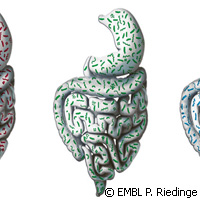Scientists discover three human gut types; what's yours?
In the same way humans can be divided into blood groups, EU-funded scientists have now discovered that we can categorise ourselves by gut type too. In a study published in Nature, an international team led by scientists from the European Molecular Biology Laboratory (EMBL) in Germany showed that microbial genetic markers are related to traits like age, gender and body-mass index. These findings are the latest from the METAHIT ('Metagenomics of the Human Intestinal Tract') project, funded in part under the 'Health' Thematic area of the Seventh Framework Programme (FP7). METAHIT, which received EU funding to the tune of EUR 11.4 million, is a 4-year-long project that began in 2008 and brings together 14 partners from China, Denmark, France, Germany, Italy, the Netherlands, Spain and the UK. The main aim of METAHIT is to find out what links there are between the genes of the human intestinal microbiota and our health and major diseases. Bacteria exist in our guts to help digest food, break down toxins and produce some vitamins and essential amino acids, as well as form barriers against invaders. Yet the composition of these bacteria varies significantly from person to person. The team first used stool samples to analyse the gut bacteria of 39 individuals from three continents (Europe, Asia and America). Later, they extended the study to include an extra 85 people from Denmark and 154 from America. They found that all of the people studied could by divided into three groups, depending on which species of bacteria occurred in high numbers in their gut. 'We found that the combination of microbes in the human intestine isn't random,' explains Peer Bork, lead researcher from EMBL. 'Our gut flora can settle into three different types of community - three different ecosystems, if you like.' Although it remains unclear why gut make-up varies from person to person, the team speculates that it could be linked to differences in how immune systems distinguish between 'good' and 'bad' bacteria. Alternatively it could be related to the different ways of releasing hydrogen waste from cells. The findings also suggest that although gut type remains independent of factors like age, gender and body-mass index, there are links. For example, the team uncovered that the guts of older people appeared more likely to have more microbial genes involved in breaking down carbohydrates than their younger counterparts. The team suggest that this boils down to the fact that as we age we naturally become less efficient at processing nutrients so it is bacteria who have to carry out this function if they want to survive in the gut. Dr Bork explains the implications of these findings for diagnosis of diseases such as colo-rectal cancer. 'The fact that there are bacterial genes associated with traits like age and weight indicates that there may also be markers for traits like obesity or diseases like colo-rectal cancer,' Dr Bork says, 'which could have implications for diagnosis and prognosis.' For patients this means that in addition to finding out what blood type you are and finding out if you suffer from any allergies, your doctor could soon be asking you to tell him about your gut and what type of bacteria live there too.For more information, please visit:European Molecular Biology Laboratory:http://www.embl.de/
Countries
Belgium, Brazil, China, Germany, Denmark, Spain, Finland, France, Italy, Japan, Netherlands, United Kingdom



